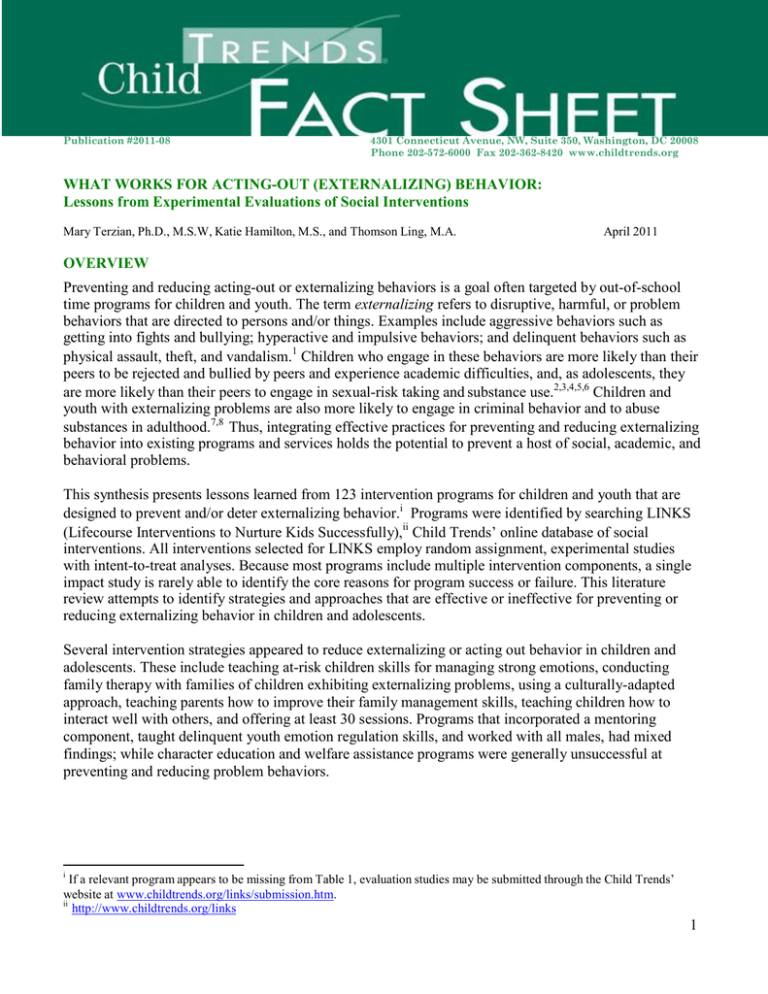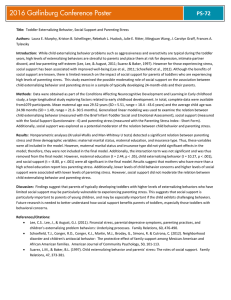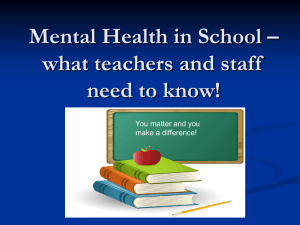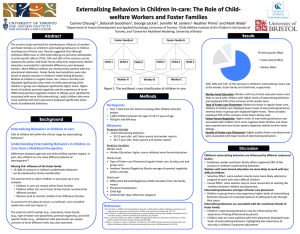Document 15542319
advertisement

Publication #2011-08 4301 Connecticut Avenue, NW, Suite 350, Washington, DC 20008 Phone 202-572-6000 Fax 202-362-8420 www.childtrends.org WHAT WORKS FOR ACTING-OUT (EXTERNALIZING) BEHAVIOR: Lessons from Experimental Evaluations of Social Interventions Mary Terzian, Ph.D., M.S.W, Katie Hamilton, M.S., and Thomson Ling, M.A. April 2011 OVERVIEW Preventing and reducing acting-out or externalizing behaviors is a goal often targeted by out-of-school time programs for children and youth. The term externalizing refers to disruptive, harmful, or problem behaviors that are directed to persons and/or things. Examples include aggressive behaviors such as getting into fights and bullying; hyperactive and impulsive behaviors; and delinquent behaviors such as physical assault, theft, and vandalism.1 Children who engage in these behaviors are more likely than their peers to be rejected and bullied by peers and experience academic difficulties, and, as adolescents, they are more likely than their peers to engage in sexual-risk taking and substance use.2,3,4,5,6 Children and youth with externalizing problems are also more likely to engage in criminal behavior and to abuse substances in adulthood.7,8 Thus, integrating effective practices for preventing and reducing externalizing behavior into existing programs and services holds the potential to prevent a host of social, academic, and behavioral problems. This synthesis presents lessons learned from 123 intervention programs for children and youth that are designed to prevent and/or deter externalizing behavior.i Programs were identified by searching LINKS (Lifecourse Interventions to Nurture Kids Successfully),ii Child Trends’ online database of social interventions. All interventions selected for LINKS employ random assignment, experimental studies with intent-to-treat analyses. Because most programs include multiple intervention components, a single impact study is rarely able to identify the core reasons for program success or failure. This literature review attempts to identify strategies and approaches that are effective or ineffective for preventing or reducing externalizing behavior in children and adolescents. Several intervention strategies appeared to reduce externalizing or acting out behavior in children and adolescents. These include teaching at-risk children skills for managing strong emotions, conducting family therapy with families of children exhibiting externalizing problems, using a culturally-adapted approach, teaching parents how to improve their family management skills, teaching children how to interact well with others, and offering at least 30 sessions. Programs that incorporated a mentoring component, taught delinquent youth emotion regulation skills, and worked with all males, had mixed findings; while character education and welfare assistance programs were generally unsuccessful at preventing and reducing problem behaviors. i If a relevant program appears to be missing from Table 1, evaluation studies may be submitted through the Child Trends’ website at www.childtrends.org/links/submission.htm. ii http://www.childtrends.org/links 1 WHAT IS EXTERNALIZING BEHAVIOR? Externalizing behaviors are negative, acting-out behaviors directed toward other people or things, such as verbal and/or physical intimidation or physical aggression, defiant or argumentative behavior, hyperactivity, impulsivity, and delinquent behaviors, such as vandalism and theft. Externalizing behaviors, for some children, can start as early as age two, and are more prone to occur in children who have a difficult temperament as infants.9 For this subgroup of children, conduct problems are more likely to be chronic. For some, externalizing behaviors are more limited to adolescence, with the onset of puberty and the physiological changes accompanying it.10 Boys are more likely to engage in externalizing behaviors than girls in middle childhood and adolescence. WHAT IMPACTS HAVE BEEN FOUND? Out of 123 programs evaluated in a random assignment study that targeted externalizing behavior, about half (a total of 69) had at least one statistically significant positive impact.. Table 1 presents programs that impact specific externalizing behaviors, according to whether they were found to work, had mixed findings, or were not proven to work. The definitions for these categories are offered below: Not Proven to Work. Programs in this category have non-significant or marginally significant impacts on a particular child or youth externalizing outcome. Mixed Findings. Programs in this category have varied impacts either on particular externalizing outcomes or at different times or for varied subgroups. For example, a program that results in significant improvements in behavior problems at post-test but has no impact at a one-year followup would be rated as having ―mixed findings‖. A program that works for one subgroup of participants but not for another subgroup (on a particular outcome) would also receive a ―mixed findings‖ rating. Found to Work. Programs in this category have positive and significant6 impacts on a particular infant, child, or youth outcome.iii Overall, 69 out of 123 rigorously evaluated programs were found to have a positive impact in at least one child or adolescent outcome (―found to work‖). Five outcome areas were identified for this synthesis: Aggression or bullying (physical fighting, physical or verbal threats or intimidation) Attention Deficit/Hyperactivity Disorder (ADHD) or inattentive, impulsive, or hyperactive behavior Delinquency (antisocial or criminal acts conducted by juveniles (youth under the age of 18, in most states; this includes things like weapon carrying, theft, vandalism, drug possession, truancy, and running away) Criminal offenses (an intentional breach of federal or state law, can be a felonies or misdemeanors; these include drug-related crimes, drunk-driving, motor vehicle offenses, domestic crimes, sex crimes, and violent and weapon-related crimes). Arrests (arrests by police for delinquent and/or criminal acts) iii Where evaluations have assessed three or more measures of a particular construct or assessed a particular outcome three or more times, we have calculated the proportion of the potential impacts that are positive and statistically significant. For example, if 4 of 7 or 5 of 9 measures for an outcome are positive and statistically significant, this would be defined as a statistically significant impact on that particular outcome. The purpose is to avoid putting programs with multiple measures either at an advantage or at a disadvantage. 2 WHAT WORKS Teaching at-risk children and youth how to identify and manage their emotions. The majority of skills-training programs (20 out of 26) that teach at-risk children and youth emotion regulation skills (such as thinking before acting or breathing deeply) were successful at reducing externalizing behavior. Emotion regulation approaches seem to work equally well for programs targeting children (11 out of 13 programs) and those targeting adolescents (9 out of 12 programs). The single program that targeted both children and adolescents was not effective. Also, this strategy was not as successful for delinquent youth (see Mixed Findings section). Conducting family therapy. Nearly all family therapy programs or programs that included a family therapy component (10 out of 12) had positive impacts on reducing at least one externalizing behavior in children and in adolescents. Developing or adapting programs to be sensitive to the culture of the target population. Although only four culturally-adapted programs were identified, the majority (3 out of 4) tended to have positive impacts on at least one externalizing behavior. Out of three effective programs, one program was specifically designed for the target population and the other two programs were adaptations of existing evidence-based programs.iv Culturally-adapted programs typically engage participants in a culturally relevant and linguistically appropriate ways and train facilitators to be aware of their own culture and sensitive to the culture of participants. Teaching parents skills related to effective communication, discipline, monitoring, supervision, and limit-setting. A slight majority of parent training programs (30 out of 47) produced positive impacts on at least one externalizing behavior. Parent training programs appear to work about as often for children (14 out of 14 programs had at least one positive impact) as for adolescents (13 out of 14 programs had at least one positive impact). Interestingly, programs targeting both children and adolescents had a lower success rate (3 out of 19 programs). Teaching interpersonal and social problem-solving skills to non-delinquent children and youth. A slight majority of social skills-training programs (28 out of 47) had positive impacts on at least one externalizing behavior. Examples of social skills include communicating well, having positive interactions with peers, resolving conflicts, and cooperating with others. Examples of social problem-solving skills include identifying a problem, coming up with solutions to the problem, evaluating these solutions, and deciding what to do. Delivering at least 30 sessions. About two-thirds of the programs that delivered at least 30 sessions (20 out of 30) were successful at decreasing at least one externalizing behavior. In contrast, about one-half (32 out of 63) of programs that delivered less than 30 sessions worked (4 out of 9 programs with 20 to 29 sessions; 18 out of 33 programs with 10 to 19 sessions; and 10 out of 21 programs with less than 10 sessions). MIXED FINDINGS Incorporating a mentoring component. Half of the programs that incorporated a mentoring component (4 out of 8) were successful at achieving a positive impact on at least one externalizing iv Programs that worked for ethnic minority youth include Families and Schools Together (for American Indian youth), 3 Familias Unidas (for Hispanic Youth), and Nuestras Familias (for Hispanic youth). 4 behavior. This proportion of effective programs may seem lower than expected, given that mentoring is often effective for other outcomes. One explanation for this may be that only two out of the seven evaluated programs focus primarily on mentoring (both worked). Also, one of the unsuccessful programs implemented only six mentoring sessions; research suggests this is not enough to produce positive impacts.11 Teaching delinquent youth how to manage their emotions. Half of the programs that taught emotion regulation skills to delinquent youth had a positive impact on at least one externalizing behavior (2 out of 4 programs using this approach worked).v Working only with males. Slightly over one half of programs specifically targeting males (nine out of 15) were successful at reducing at least one externalizing behavior. NOT FOUND TO WORK Teaching interpersonal and social problem solving skills to delinquent youth. Although based on a small group of studies, social skills training programs were not as frequently effective for delinquent youth, with only two out of six programs achieving positive impacts.vi Character education programs that focus only on promoting nonviolence, respect, and peaceful resolutions to conflicts. Although based on a small handful of programs, this review found that two out of six approaches focused on changing attitudes towards violence and promoting peaceful resolutions to conflicts tended to be less likely than other approaches to reduce acting-out behavior.vii Programs that encourage family economic well-being. Although only five were reviewed, programs designed to reduce family disadvantage and promote economic well-being generally did not reduce externalizing behavior (only one out of five programs led to positive impacts).viii NEEDED RESEARCH Interventions that seek to alter peer influences and dynamics. Despite the important role peers play in social development, few programs intervene at the level of the peer group. One program that does target the peer group, The Good Behavior Game,12 has been found to have long-term impacts on classroom aggression on a subsample of boys who exhibited high levels of pretest aggression in the first grade. This program uses classroom behavior management techniques to v Worked (2): Functional Family Therapy and Equipping Youth to Help One Another (EQUIP); Mixed Findings or Did Not Work (2): Reaffirming Young Sisters' Excellence (RYSE) and South Oxnard Challenge Program. vi Worked (2): Multidimensional Treatment Foster Care (MTFC) and Equipping Youth to Help One Another (EQUIP); Mixed Findings or Did not Work (4): Reaffirming Young Sisters' Excellence (RYSE), North Carolina Court Counselors IPSP, Skillman Aftercare Experiment, Violent Juvenile Offender Program vii Worked (2): Positive Action and Peacebuilders; Mixed Findings: All Stars, Resolve It, Solve It, Responding in Peaceful and Positive Ways (RIPP); Not Found to Work: Aggressors, Victims, & Bystanders. viii The single program that achieved a positive impact (Early Head Start) offered an array of additional services – center-based services such as child care, parenting classes, and parenting support groups, home-based services such as weekly home visits, and referrals to other community services. However, so did Early Start, which did not impact externalizing behavior. Other programs found not to work included New Chance and the Self Sufficiency Project. One program, Moving to Opportunity, 5 resulted in mixed findings (See Table 1). 6 promote positive peer group dynamics and has achieved considerable success. In addition, peer mediation strategies may hold promise but have not been rigorously evaluated. Job training programs that seek to improve youth’s vocational or employment skills. Applying a social developmental approach which emphasizes the importance of opportunities for involvement and success, job training programs may decrease the likelihood that youth will engage in antisocial and/or criminal behavior. This review identified only three experimentally- evaluated job training programs, one of which (Job Corps) worked to reduce criminal offenses and arrests. Early childhood education programs that assess impacts on externalizing behavior. Only two early childhood education programs were identified that assessed externalizing behavior. Both program evaluations were conducted with predominantly African American samples. While one program, Ready to Learn, was found to improve the teacher-rated behavior of 4- to 5-year-old children, the other program, High/Scope Perry Preschool, had long-term impacts –resulting in significantly fewer arrests when youth were aged 19, but, by age 27 years, the impact remained solely for males (resulting in a mixed finding). These findings suggest a need for future evaluations of early childhood education programs to assess both short- and long-term behavioral outcomes. Interventions that target high-risk females. Gender-specific programming for female juvenile offenders is becoming more common, recognizing that the pathways to delinquency differ between males and females and also given the fact that males and female delinquents are placed in gender-specific facilities. However, only one experimentally-evaluated program for females, Reaffirming Young Sisters' Excellence, was identified. This contrasts with 15 male-only programs. Knowledge about how intensive programs must be to achieve positive impacts. The duration of evaluated programs ranged from 1 day to 10 years;ix the number of sessions ranged from 1 to 520; and, for programs implemented over time, the number of times per week ranged from one to seven. Yet, evaluations do not often conduct efficacy analyses to examine the effect of this variation or randomly assign participants to multiple intervention conditions that differ primarily in program intensity. This contrasts with pharmaceutical treatments; doctors, for example, can recommend how much, how often, and for how long their patients should take a specific medication in order to achieve the maximum benefit. More research is needed on how to involve and engage students who have behavior problems in out-of-school time programs. Students who already exhibit behavior problems may be more likely to have low levels of attendance and to drop out of programs than students who do not. Yet strategies for recruiting, retaining, and engaging these youth in voluntary out-of-school time programs have not yet been evaluated. Interestingly, only 9 out of 28 programs implemented among delinquent youth were successful, suggesting the need to eliminate ineffective strategies and develop more tailored strategies for this population. Few studies measure long-term impacts. Despite the large number of experimentally-evaluated programs, less than one half (47 out of 123) evaluated impacts that occur at least one year after program completion. Because programs with long-term impacts are preferable to those without ix Fast Track is a 10-year intervention (offered from grades K-12), whereas Teen Court is a one-day intervention. 7 them, distinguishing between those that do and do not promote long-term behavioral improvement is important to inform decision-makers about which programs to fund. DISCUSSION This review of experimentally-evaluated social programs for children sought to review program impacts on various types of externalizing behaviors and identify strategies that work and strategies that do not work to reduce externalizing or acting out behavior in children and youth of all ages. Slightly over onehalf of the interventions reviewed in this synthesis (69 out of 123) reduced externalizing behavior (21 had mixed findings and 33 did not have impacts). Impacts were found for aggressive/bullying behavior (56 out of 93 programs), delinquent behavior (12 out of 22 programs), arrests (9 out of 22 programs), criminal offenses (4 out of 13 programs) and attention deficit and hyperactivity disorder and/or its symptoms (2 out of 6 programs). Finally, over half of the programs that were evaluated at least one year after program completion (20 out of 44) had long-term impacts; 10 programs had mixed findings and 14 did not have any long-term impacts. Among these 20 programs, 10 targeted children only, eight targeted adolescents only, and two targeted both children and adolescents. Out of the 20 programs that had long-term impacts, slightly over half (12) were universal programs – implemented regardless of whether participants were currently exhibiting acting-out behaviors –and the remaining (8) were indicated programs – solely involving children and/or adolescents with acting-out behaviors.x By and large, many programs that teach at-risk children and youth how to manage strong emotions can reduce externalizing behavior. In addition, programs that provide family therapy (often) or parent training (fairly often) are effective at reducing externalizing behavior. Programs that are culturally-adapted tend to work for ethnic minority youth, and programs that teach children how to manage emotions, solve interpersonal problems, and interact in friendly or prosocial ways with others tend to be successful for low- and moderate-risk youth. Less definitive evidence was found for programs that incorporate mentoring, reflecting the fact that a precise definition of the concept is needed, as well as further research. In addition, character education and welfare assistance programs were not often found to be successful at reducing acting out or externalizing behavior among children or youth. However, most of the character education programs reviewed tended to focus on a very narrow set of character strengths –mainly those related to respect and nonviolence – which is not typical of most character education programs. Areas of needed research include studies that compare impacts for shorter- and longer-term versions of a program, strategies to recruit and retain at-risk youth, and studies that assess long-term impacts. Moreover, additional random assignment evaluations of programs that seek to intervene at the level of the peer group and of those that employ a gender-specific approach are needed. Finally, evaluations of job training and early childhood education programs may benefit from extending beyond their traditional range of outcome measures to include measures of externalizing behaviors. x Multidimensional Treatment Foster Care, Parenting with Love and Limits, Multisystemic Therapy, Montreal Prevention Experiment, Parent Management Training, Equipping Youth to Help One Another, Restorative Justice Conferencing, Preventing Adolescent Problems 8 ENDNOTES 1 Hann, D., & Borek, N. (2001). Taking stock of risk factors for child/youth externalizing behavior problems. NIH publication no. 02-4938. Washington, DC: National Institute of Mental Health. 2 Wood, J. J., Cowan, P.A., & Baker, B. L. (2002). Behavior problems and peer rejection in preschool boys and girls. Journal of Genetic Psychology, 163, 72-88. 3 Schwartz, D., McFayden-Ketchum, S., Dodge, K. A., Pettit, G. S., & Bates, J. E. (1999). Early behavior problems as a predictor of later peer group victimization: moderators and mediators in the pathways of social risk. Journal of Abnormal Child Psychology, 27, 191–20. 4 Timmermans, M., van lier, P. A. C., & Koot, H. M. (2008). Which forms of child/adolescent externalizing behaviors account for late adolescent risky sexual behavior and substance use? Journal of Child Psychology and Psychiatry, 49(4), 386-394. 5 Molina, B.S.G., & Pelham, W. E. (2003). Childhood predictors of adolescent substance use in a longitudinal study of children With ADHD. Journal of Abnormal Psychology, 112, 497–507 6 Hinshaw, S. P. (1992). Externalizing behavior problems and academic underachievement in childhood and adolescence: Causal relationships and underlying mechanisms. Psychological Bulletin, 111, 127-155. 7 Campbell, S. B. (2002). Behavior problems in preschool children: Clinical and developmental issues (2nd ed.). New York: Guilford Press. 8 Campbell, S. B., Spieker, S., Burchinal, M., Poe, M. D., & NICHD Early Child Care Research Network. (2006). Trajectories of aggression from toddlerhood to age 9 predict academic and social functioning through age 12. Journal of Child Psychology and Psychiatry, 47, 791-800. 9 Tremblay, R.E., Pihl, R. O., Vitaro, F., Dobkin, P. L. (1994). Predicting early onset of male antisocial behavior from preschool behavior. Archives of General Psychiatry,51, 732–738 10 Moffitt, T. E. (1993). Adolescence-limited and life-course-persistent antisocial behavior: A developmental taxonomy. Psychological Review, 100, 674-701. 11 Herrera, C., Sipe, C.L., & McClanahan, W.S. (2000). Mentoring school-age children: Relationship development in community-based and school-based programs. Public/Private Ventures, Philadelphia, PA. (Published in collaboration with MENTOR/National Mentoring Partnerhsip, Alexandria, VA) . 1212 Kellam, S. G. & Anthony, J. C. (1998). Targeting early antecedents to prevent tobacco smoking: Findings from an epidemiologically based randomized field trial. American Journal of Public Health, 88, 1490-1495. © 2011 Child Trends. May be reprinted with citation. The support of the Edna McConnell Clark Foundation and The Stewart Trust are gratefully acknowledged. Child Trends is a nonprofit, nonpartisan research center that studies children at all stages of development. Our mission is to improve outcomes for children by providing research, data, and analysis to the people and institutions whose decisions and actions affect children. For additional information, including publications available to download, visit our Web site at www.childtrends.org. For the latest information on more than 100 key indicators of child and youth well-being, visit the Child Trends DataBank at www.childtrendsdatabank.org. For summaries of over 500 evaluations of out-of-school time programs that work (or don't) to enhance children's development, visit www.childtrends.org/WhatWorks. 9 Table 1. What Works: Lessons for Experimental Evaluations of Social Interventions to Reduce Acting-out or Externalizing Behavior OUTCOME NOT PROVEN TO WORK Aggression/ Adolescent Transitions Program (Parent and Teen Bullying Focus) Adolescent Transitions Program (Teen Focus) Aggressors, Victims, & Bystanders Attachment and Biobehavioral Catch-Up Building Educated Leaders for Life (BELL) Summer Learning Program Child Health Supervision Cognitive Behavioral Intervention for Trauma in Schools Early Risers Early Start Mentor-Implemented Violence Prevention Intervention for AssaultInjured Youth Metropolitan Area Child Study Minnesota Competence Enhancement Project Montreal Prevention Experiment New Chance Parent-Child Interaction Therapy Primary Project Problem Solving Program for Childhood Obesity Social Skills Training Program for Children's Social Functioning Students Managing Anger Resolution Together (SMART) Team Assisted Individualization for Math MIXED FINDINGS Aban Aya Youth Project Significant impacts found for boys but not girls. FOUND TO WORK Adolescent Transitions Program (Comprehensive) Al's Pals Adolescent Transitions Program Anger Coping Program Big Brothers, Big Sisters (Parent Focus) --Impacts reported at posttest by parents, Brain Power but not teachers; also these Child Parent Psychotherapy for Family impacts dissipated after one Violence year. Children Are People Too All Stars -- Impacts vary by race Children of Divorce Intervention Program and by who delivers the intervention. Clinician-Based Cognitive Psychoeducational Intervention for Catch'em Being Good -- No Families impacts on girls. Cognitive Behavioral Family Intervention Good Behavior Game -- Only worked for boys with high levels Cognitive Behavioral Training Program of aggression at baseline. for Behaviorally Disordered Adolescents Leadership Education Through Cognitive-Relaxation Coping Skills Athletic Development -- No Coping Power Program impacts on girls. Dare to be You Moving to Opportunity -Early Head Start Impacts for boys in one study, Equipping Youth to Help One Another but no impacts for girls. Even Start New Beginnings -- Children Experience Corps with mental health problems at Familias Unidas baseline were affected by the Families and Schools Together program. (American Indian Adaptation) Peer Coping Skills Training -Families First Impacts found for aggressive Family Behavior Therapy children but not nonaggressive Fast Track Prevention Project children. First Step to Success Focus Positive Parenting Impacts on Families Functional found for on parent-rated but Family Therapy Incredible not child-rated aggression. Years Series Reaching Educators, Children Linking the Interests of Families and and Parents – RECAP -Teachers Impacts found using teacher Multidimensional Treatment Foster Care report but not using parent Multisystemic Therapy report. Nuestras Familias 10 OUTCOME NOT PROVEN TO WORK MIXED FINDINGS Responding in Peaceful and Public Ways (RIPP) -- No impacts on girls. Aggression/ Bullying Resolve It, Solve It -- Reduced (continued) person-directed physical aggression but not verbal assault, person-directed physical assault and objectdirected physical assault. FOUND TO WORK Parent Management Training - Oregon Model Parent Mediated Treatment Program Parenting Adolescents Wisely Parenting with Love and Limits Peacebuilders Penn Prevention Program Positive Action* SAFEChildren -- Impacts found for children identified as highrisk only. Schools and Homes in Partnership -- Reduced 2 out of 8 measures of aggressive or antisocial behavior; impacts were weaker for girls. Staying Connected with Your Teen (formerly Parents Who Care) – Follow-up impacts found for black youth only. ADHD Leadership Education Through Athletic Development Social Skills Training Program for Children with ADHD SAFEChildren – Impacts found for children identified as highrisk only. Project Belong Project Support Project TALC (Teens and Adults Learning to Communicate) Promoting Alternative Thinking Strategies (PATHS) Raising Healthy Children Ready to Learn Reconnecting Youth RELATE Program for Teens School-Based Intervention to Reduce Aggressive Behavior in Maladjusted Adolescents Second Step Social Learning Parent Training Social Problem Solving STAR (Stop, Think, Ask, Respond) Parenting Program Strengthening Families Program – 10-14 Structured Learning Training Teen Outreach Program Tools of the Mind Triple P-Positive Parenting Program Parenting with Love and Limits Project TALC (Teens and Adults Learning to Communicate) *This synthesis has been updated since March 2011 to reflect a correction to the rating of the Positive Action programs from ―Mixed Findings‖ to ―Found to Work‖. 11 OUTCOME NOT PROVEN TO WORK MIXED FINDINGS FOUND TO WORK Boot Camp Coping Power Program – Impacts were found for parent-report Consulting Program for delinquency, but not child-report Teachers to Prevent delinquency. Vandalism Intensive Supervision Program in Detroit Michigan Mentor-Implemented Violence Prevention Intervention for Montreal Prevention Delinquency Assault-Injured Youth – Impacts Experiment were found for some types of North Carolina Court delinquency, but not others. Counselors IPSP Preventing Adolescent Problems San Quentin Squires Program Self Sufficiency Project Teen Court Toddlers Without Tears Aban Aya Youth Project Brief Strategic Family Therapy Cognitive-Relaxation Coping Skills Family Behavior Therapy Informed Parents and Children Together (ImPACT) Life Skills Training Multidimensional Treatment Foster Care Multisystemic Therapy Parenting Through Change Positive Parenting Criminal offenses Cambridge-Somerville Youth Study Mississippi Department of Correction’s Project Aware Program Paint Creek Youth Center Program Skillman Aftercare Experiment Teen Court Violent Juvenile Offender Program Cambridge-Somerville Youth Study Arrests Discharge from Parole Job Training Partnership Act North Carolina Court Counselors IPSP Reaffirming Young Sisters' Excellence (RYSE) San Quentin Squires Program South Oxnard Challenge Program Teen Court Violent Juvenile Offender Program Buddy System – Youth who had been arrested for a major offense within the year before the program were less likely to re-offend, but those with no such prior record were more likely to re-offend. Discharge from Parole – Impacts were found on some aspects of criminal offending, but not others. Insiders Juvenile Crime Prevention Program Intensive Supervision Program in Detroit Michigan Job Corps Montreal Prevention Experiment Multidimensional Treatment Foster Care Project Belong Buddy System JobStart – One study found impacts Fast Track Prevention Project on arrests, but another did not. Functional Family Therapy High/Scope Perry Preschool Program Insiders Juvenile Nurse Family Partnership— Crime Prevention Program Intensive Mother-report of arrests were Supervision Program in Detroit significantly lower in the pregnancy/infancy group, but not Michigan in the pregnancy group; for Job Corps children whose mothers are not Multidimensional Treatment Foster Care married and have low income, program impacts were not found Multisystemic Therapy for either group. Restorative Justice Conferencing 12





